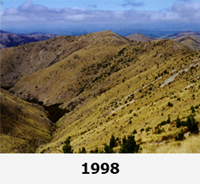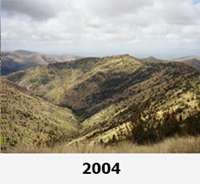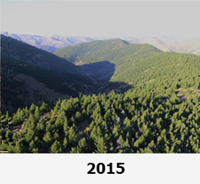-
On this page:
- The problem and the threat
- How wildings are controlled
- Working together to stop the spread
- The National Programme
- Progress under the national programme
- What farmers and forest owners can do
- Research and analysis
- Find out more



Wilding conifers are a threat to our land and farms
Planted in the right place, and properly managed, some introduced conifers can:
- provide timber
- store carbon
- decrease erosion
- filter soil nutrients
- improve water quality
- provide shelter and shade for stock.
In the wrong place, certain species of conifers are a major threat to New Zealand's ecosystems, land, and farms.
While plantation forestry is typically planted between 600 to 1,100 stems per hectare, self-seeded Pinus contorta and other wilding conifers grow as densely as 10,000 stems per hectare if not controlled. This is too dense to walk through,
It's estimated 25% of New Zealand would be covered in unwanted wilding conifers within 30 years if they were left to spread. Wilding conifers currently affect more than 2 million hectares of New Zealand. Despite past control efforts, they were spreading across about 90,000 hectares a year before the National Wilding Conifer Control Programme was established.
What is a wilding conifer
Wilding conifers are self-seeded trees. Most of New Zealand’s wilding conifers are the legacy of plantings between the 1800s and mid-1900s. The worst, fastest spreading wilding conifer species is Pinus contorta or Lodgepole pine – declared an unwanted organism in 2010.
Learn more about high-spreading species in the Wilding Conifer Quick ID Guide [PDF, 188 KB]
Wilding conifers include other species of pines, firs and larch (any type of conifer) that spread where they are not wanted and are hard to control:
- Seeds from high-spreading species can be blown many kilometres by wind, and quickly infest vulnerable landscapes in affected regions.
- They spread into farmland, and public conservation land, with the ability to grow high above the native bush line in hills and high country.
- Once established, wilding conifers compete with native plants for sunlight and water. This is especially problematic in in sensitive catchments like the South Island high country including around our hydroelectricity lakes.
- Within a few years they can severely alter natural landscapes and obscure the views New Zealand is famous for.
In different locations, wilding trees grow at different rates and in different densities. Often they are in terrain that is hard to get to.
Controlling the spread of self-seeded wilding conifers is important if we're to protect our ecosystems, iconic landscapes, farms and our lakes
How wildings are controlled
Wilding conifers are controlled in New Zealand using several methods including:
- hand-pulling or hand-sawing young seedlings
- sawing or chain sawing medium to large trees
- using herbicide, either injected directly into the tree, or applied to bark, or in specific circumstances (less than 1% of all control work), sprayed over foliage.
- Forestry harvesting methods are used to fell mature trees for logs or biofuel, where it is cost effective and can be done safely.
The National Wilding Conifer Control Programme helps test and trial proposed control methods and produces good practice guidance for using new methods.
Protecting the surrounding environment, people, and property near the wildings while doing the control work is a priority. A lot of planning goes into selecting the safest and most effective control method for each site. This includes considering:
- safe access for contractors and equipment
- nearby land uses
- tree size and species
- size and density of the infested area
- native ecological significance of surrounding land
- practicality and cost effectiveness.
Drones that can spray precise targets are being trialled to control scattered trees, or those that can’t be safely reached with other methods, using the lowest possible amount of herbicide.
Drone vs wilding pine – YouTube (2.03)
Working together under a national strategy
In 2014 a cross-sector group, led by Biosecurity New Zealand, developed a national strategy. It recommended a coordinated and collaborative approach – combining efforts around the country and working together would increase the chances of stopping the spread and removing wildings.
'The Right tree in the right place: The New Zealand wilding conifer management strategy 2015–2030' provides the framework for the National Programme:
The wilding conifer management strategy 2015–2030 [PDF, 1.3 MB]
The majority of actions recommended in the original strategy have now been delivered or integrated into the ongoing Programme. Biosecurity New Zealand is currently engaging with partners in preparation to refresh the National Strategy looking beyond 2030.
The National Wilding Conifer Control Programme
The National Wilding Conifer Control Programme was established in 2016, to deliver the aims of the National Wilding conifer Management strategy 2015-2030. The programme is a partnership between central and local government agencies with the farming and forestry industries, landowners, the community sector, and a wide range of stakeholder groups.
Find out more about the national control programme – Wilding Pines
Government funding to date
- In 2016, the government pledged $16 million over 4 years for the first phase of the national programme, used for wilding conifer control in a few of the highest priority areas.
- In 2019, a further $21 million was allocated over 2 years.
- In early 2020, $3 million from the COVID-19 relief package was used to redeploy workers affected by the pandemic into wilding control.
- Budget 2020 allocated further Crown funding of $100 million over 4 years to expand the national programme.
- From the 2024-25 financial year, the Programme has $10 million of annual baseline funding through Biosecurity New Zealand (MPI)
- The Programme has been allocated additional funding through the International Visitor Levy in 2023-24 ($7 million) and 2024-25 ($3.35 million), and 2025-26 ($3 million).
- For the 2025-26 financial year, Ministers announced an additional $2 million of funding.
Other contributors to wilding control
Partner contributions to the Programme, in funding or in-kind support, have totalled more than $25 million between 2016 and 2025, from councils, community Trusts, landowners and others.
Many other wilding control efforts are not reported, including volunteer hours, landowners controlling wildings on their own land, Iwi and community trusts and industry working together in special places. This work is important, limiting the spread of wildings and protecting unique landscapes and habitats.
Progress under the national programme
Around 75% of the known infestation has received at least one round of control work through the national programme.
2016 to 2018
In the programme's first year (2016 to 2017) the partners controlled and prevented the spread of wilding conifers across around 1.2 million hectares of New Zealand's high country. Its success was due to the funding support and commitment of all involved – wilding tree management groups, landholders, and central and local government.
The programme carried out control work over a further 371,000 hectares in 2017 to 2018.
2020 to 2021
From July 2020 to June 2021, the wilding conifer work programme and partners spent almost $40 million on control, delivering work on 817,000 hectares.
2021 to 2022
Eight new management units (MUs) were brought into the programme. MUs are geographical areas used by the programme to divide up regions into smaller areas, for the purpose of planning control work. The Programme had active MUs across 80% of the known infestation area.
2022 to 2023
The Programme’s work to improve wilding conifer management included:
- Collaborating with research partners to test the use of Large Learning Models (a type of artificial intelligence) to detect wilding pines from aerial photography.
- Advised on policy changes to reduce the risk of wilding spread from new forestry plantings including continuous cover exotic forests.
- Completed improvements to the Wilding Conifer Information System.
- Supported trials of new control methods that could reduce costs and enable control operations in locations where existing methods are not practical or safe to use.
Control operations:
- Control crews delivered operations work across 470,000 hectares of land area affected by wildings. Around 672 control operations were conducted across 377 operational sites.
- Total investment in control operations recorded through the National Programme was about $24 million (including $2 million in contributions from partners).
2023 to 2024
- The Programme undertook a Transition Planning Pilot project in the first operational area where wilding conifers have been successfully reduced to very low levels, to test and refine guidelines for transferring responsibility for wilding control back to land occupiers.
- Guidance on working in high fire-risk conditions was provided to control partners and summarised in a training video for new crew members.
Wilding prevention during wilding control operation – YouTube (7.37)
Control operations:
- Control crews delivered operations over more than 280,000 hectares of affected land.
This was primarily focused on priority maintenance control on land previously controlled, to remove remaining coning trees and new seedlings. This is needed in 3-yearly cycles following initial control, to prevent re- infestation from seed in the ground or blowing in from remaining seed sources. - Total investment in control operations recorded through the National Programme was about $18 million, including around $3m in contributions from partners.
2024 to 2025
In the first year of $10 million annual baseline funding, the Programme’s work included:
- Publishing new and updated 'Good Practice Guidance' for wilding conifer management, including guidance for trialing the use of drones, guidance for post-control monitoring, and safety guidance for remote and isolated work.
Good Practice Guidance – Wilding Pines - Collaborating with partners including the Department of Conservation, Federated Farmers, Scion (Biological Science Institute) to assess the potential of grazing to suppress young wildings especially Pinus contorta.
- Working with Fire and Emergency New Zealand on wildfire risk management where wilding pines present dangerous fuel loads, such as in the December 2024 Bridge Hill wildfire.
- Supporting increasingly complex control operations where extra care is needed to protect the surrounding natural environment, historic features and community uses of land.
- Control crews delivered wilding conifer control operations on around 180,000 hectares* across 9 regions.
- Total investment in control operations recorded through the National Programme was around $14 million, supported by around $4m in contributions from partners as well as $3.35m the International Visitor Levy.
2025 to 2026
For the 2025/26 financial year, the Ministers for Biosecurity and Agriculture jointly announced an addition $2 million for control operations in addition to $10 million baseline funding, bringing the Programme’s budget for this year to $12 million.
Tackling wilding pines to boost resilience – Beehive
In addition, the Minister for Conservation announced an additional $3 million from the International Visitor Levy for control operations to protect landscapes and biodiversity in the Mackenzie Basin in Canterbury and Molesworth Recreation Reserve in South Marlborough.








